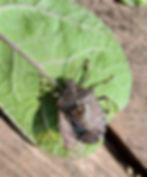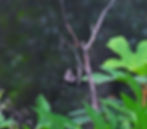What to do About Joro Spiders?
- ljmarkson
- Aug 7
- 5 min read
This is the first year I’m seeing the invasive Joro spiders in my little habitat yard and I’m exploring what to do. They are originally from East Asia and were first found in the US in North Georgia in 2014. It is thought the Joro spiders came over in shipping containers at some point. They naturally disperse at a rate of about 10 miles per year by “ballooning” as tiny spiderlings using a thread of silk to catch the wind and float. People have also inadvertently helped Joro spiders move around the country in a variety of ways such as in cars, truck, luggage, and nursery plants. There's a possibility that Joro spiders will eventually spread throughout the East Coast and maybe beyond because they are cold tolerant.

I added my Joro spider sighting to others in my Atlanta neighborhood on iNaturalist. I also participated in the community-science website Joro Watch to document my observations. Joro spiders are born in the spring but aren’t typically noticed until August when they start maturing - which I’m sure is why I’ve noticed them in just the last week or so. By fall when they're over an inch long they're hard to miss!

According to the UGA College of Agriculture the good news is Joro spiders aren’t a “bad invasive species” and don’t compete with native spiders for food and may actually help catch more insects. Joro spiders are not aggressive but shy, docile, and don't typically bite. They are also one of the few predators of invasive brown marmorated stink bugs that also come from Asia. The bad news is each spider lays hundreds of eggs each year; and adult spiders create large, strong, and super sticky three-dimensional webs to trap native insects. You can’t avoid seeing or bumping into Joro spider webs! In various online Southeast nature groups, people are anecdotally complaining about Joro spiders replacing other common yard spiders. There are indications that native spiders and Joro spiders might be able to coexist and there are studies pointing to trouble ahead: Joro spiders do better than native spiders in populated places; native orb-weaving spiders are declining by 40% each year and Joro spiders are doubling each year; and there’s evidence that in areas with abundant Joro spiders there aren’t as many native spiders.

I noticed a tiny marbled orb weaver on a shrub near our driveway a few weeks ago and took some pictures. Last week I didn’t see the orb weaver but noticed a Joro spider web nearby. I realize it may not be related - there is heavy bird pressure eating insects in my yard because it’s the only rewilded one around. Yet I can see how these two observation might seem to be related even though I have no clue if they are.

UGA’s cooperative extension says Joro spiders have already established themselves and are here to stay. For perspective there are hundreds of non-native insects and spider species in the US according to the Department of Agriculture.

Experts maintain the Joro spiders are not disruptive to the ecosystem. Yet they more recently said no one should allow the webs to remain around pollinator or flower gardens. This message is where it gets murky and confusing as I’m not sure what this means in a ¼ acre rewilded yard like mine where the entire yard is considered a wildlife habitat and from a more traditional gardening perspective would be called a pollinator or flower garden. This advice would seem to mean that Joro spiders do impact a yard ecosystem.

I have a difficult time killing living creatures for any reason. Random spiders and other insects that make their way into my home are taken outside. I don’t police my yard for non-native insects because, well, there are so many in Georgia. The good bug/bad bug paradigm has resulted in widespread fear of insects that normalize insects being killed on sight unless they’re “good bugs” like butterflies. There's a macabre glee people take in killing “bad” insects or wildlife which is just not respectful of living beings. Pest control companies have done a fantastic job of culturally defining wildlife (meaning all living things) by their subjective value to people. They continue to normalize a weird fantasy that outside spaces need to be treated like a living room and be “bug free” for people to enjoy. Nancy Lawson, the Humane Gardener is spreading the word far and wide about thinking more about this kind of meaningless language that normalizes false dichotomies such as insects as either a "pest" or "beneficial".

Invasive insects are such a complicated situation that magnifies the bad bug idea. Killing invasive insects often results in native look-alike species being mistaken for invasives. In the Southeast Joro spiders can be confused with golden silk-orb weavers, yellow garden spiders, and banded garden spiders.

Just about all invasive species exist because of human activity and it’s difficult to manage them once they’re here. Researchers agree that more study is needed to find out whether Joro spiders will outcompete native spiders or otherwise damage East Coast ecology. For now, they suggest learning to live with them and suggest that there's no point in excess cruelty where it's not needed. I’m not an ecologist, and assume this stance is for a number of reasons even though it's not completely intuitive for the rest of us to understand. It looks like pest control companies take a page from this advice and so far they are not advertising to specifically treat Joro spiders with pesticides. Maybe this outcome is a factor the experts consider so as to not encourage professional treatment for Joro spiders which would involve broad spectrum pesticides that would do more harm to the ecosystem than the spiders could do.
There’s hope that the spread of Joro spiders may be self-limiting. A recent intriguing study by UGA’s Andy Davis (who seems to be a key Joro spider researcher) observed Joro spiders may be their own worst enemy because they turn hostile to each other when stressed and will resort to cannibalism which is a rare phenomenon outside of mating. For now, I’ll remove Joro spiders where it’s unavoidable to bump into them and continue to cautiously ponder what to do when I see them in my rewilded yard.

Note: There are no affiliate links in this blog. The highlighted text throughout the post includes blog posts I've written; data links; details; explanations; worthy organizations or businesses; or examples I think might be helpful


.jpg)
